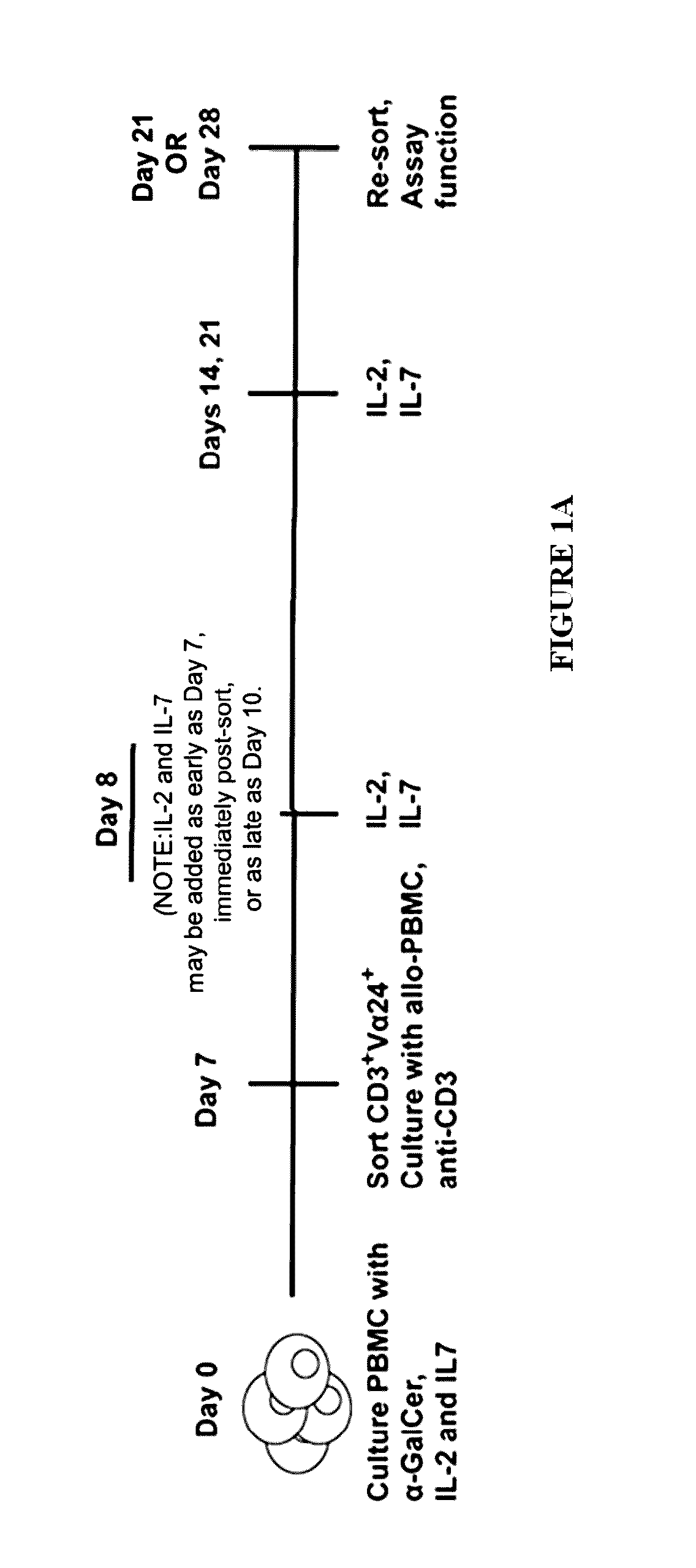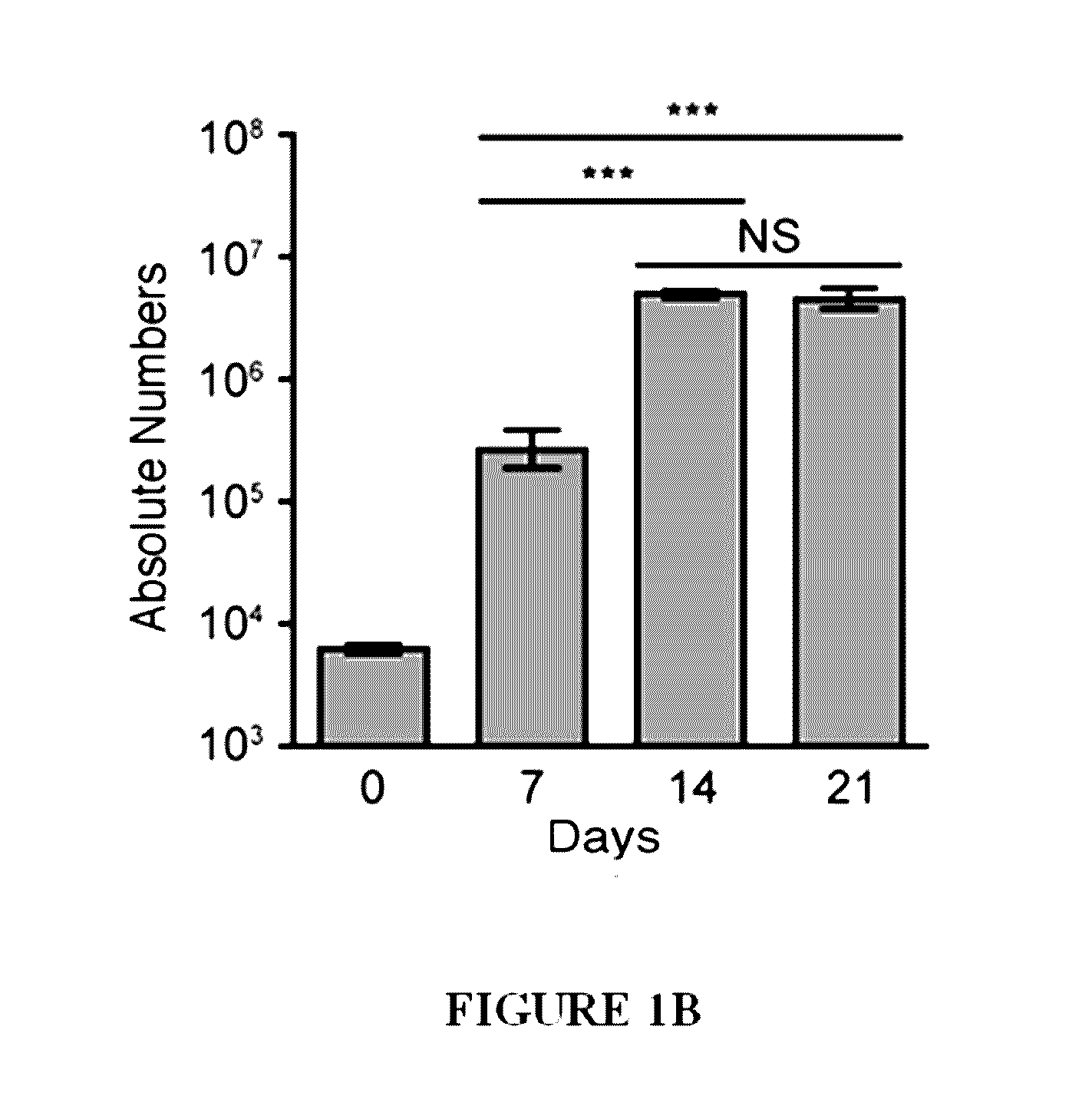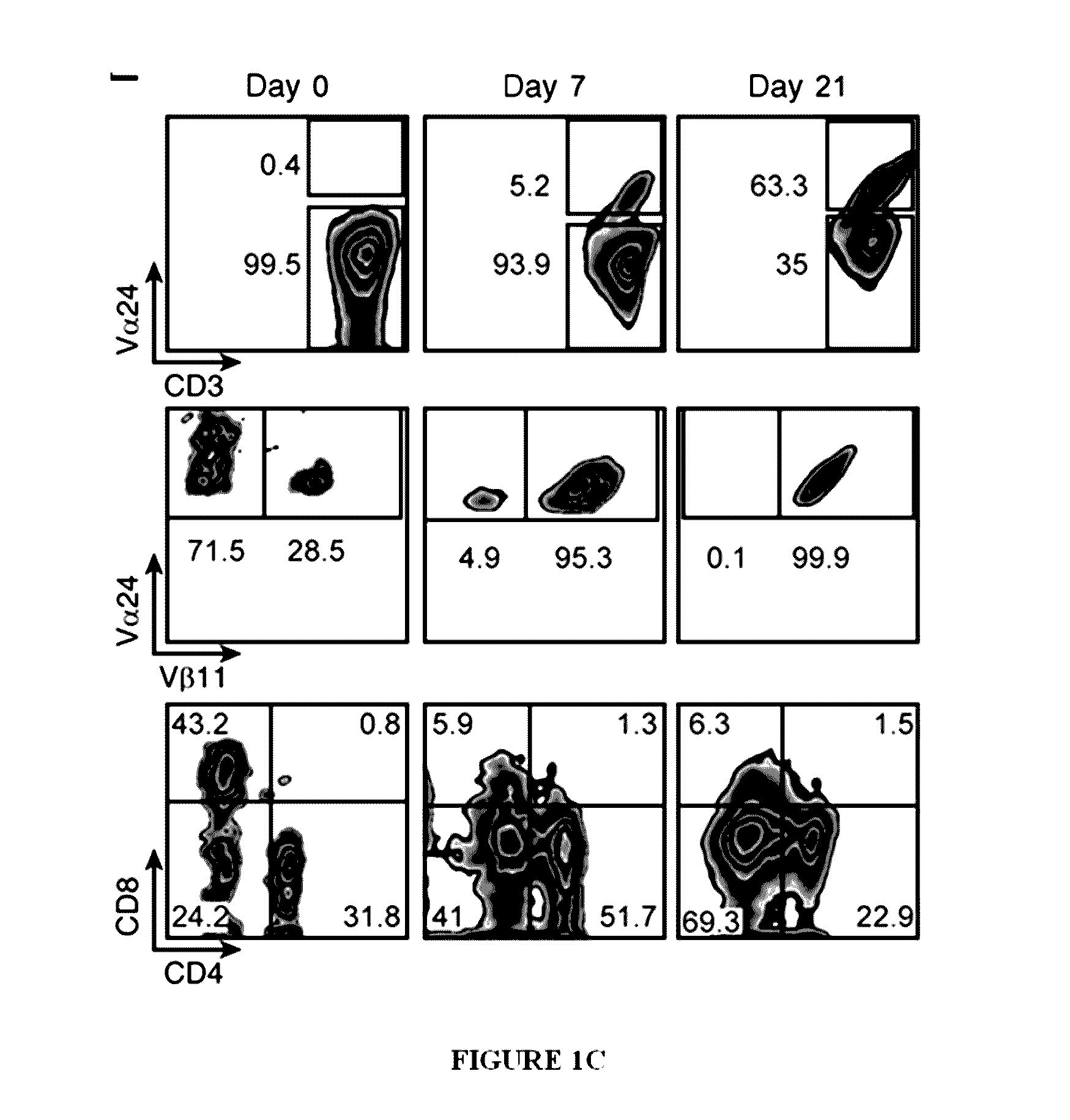Methods of expanding ex vivo natural killer t (NKT) cells and therapeutic uses thereof
a technology of ex vivo natural killer cells and ex vivo expansion, which is applied in the field of ex vivo expansion of natural killer cells and therapeutic uses thereof, can solve the problems of lack of the technology necessary to efficiently expand and/or modulate the activity of nkt cells ex vivo enough, and the relative scarcity of human innate regulatory inkt cells in immunotherapy, etc., to achieve the effect of augmenting cytotoxicity, augmenting cytotoxicity, and augmenting cytotoxicity
- Summary
- Abstract
- Description
- Claims
- Application Information
AI Technical Summary
Benefits of technology
Problems solved by technology
Method used
Image
Examples
example 1
[0154]CD1d-restricted iNKT cells are rare but potent innate regulatory cells capable of immune modulation as well as directing anti-tumor cytotoxicity. Protocols to expand iNKT cells and augment their cytotoxicity would allow their application in allogeneic transplantation and anti-tumor immunotherapy. The present example demonstrates ex vivo expansion of highly purified CD3+Vα24+ iNKT cells from human PBMCs.
[0155]This example demonstrates a novel method for ex vivo activation and expansion of human iNKT cells with both alloregulatory and cytotoxic effector function.
[0156]This example discloses a method whereby PBMCs were stimulated with the iNKT-specific glycolipid α-GalCer, recombinant IL-2 and IL-7. After sorting to >98% purity on day 7, iNKT cells were further expanded in the presence of irradiated allogeneic PBMCs, anti-CD3 antibody, IL-2 and IL-7, and re-sorted on day 21-28 for immunophenotyping and functional studies. Upon activation, the expanded iNKT cells secreted high lev...
example 2
[0199]Allo- and tumor antigen-specific graft-versus-tumor activity (GVT) after hematopoietic cell transplantation (HCT) facilitates immunotherapeutic cure of pediatric leukemias. However, application of HCT is limited by toxicities including lethal graft-versus-host disease (GVHD) when CD8+ T cells are used to drive GVT. Immunosuppressive treatments to prevent or treat GVHD, in turn, inhibit GVT. Therefore, at least one major goal within the art of pediatric allo-HCT for malignancies, is to develop technology to separate GVHD from the GVT capacity of an allograft.
[0200]Several recent clinical attempts have been made to optimize GVT against pediatric acute lymphobiastic leukemia (ALL) and acute myeloid leukemia (AML) without GVHD using expanded human natural killer (NK) cells to drive GVT (Ruggeri et al Science 2002, 295(5562): 2097-2100; Ruggeri et al Blood 2007, 110:433-440; Triplett et al, Blood 2006, 107(3):1238-9; Rubnitz et al, 2010, Journal of Clinical Oncology 28(6):955-9.) H...
example 3
Cytotoxicity of Ex Vivo Expanded Human NKT Cells
[0209]The cytotoxicity of ex vivo expanded NKT cells (both iNKT and gamma-delta subset NKT) produced according to methods described herein is characterized against pediatric B- and T-ALL, AML, neuroblastoma, alveolar rhabdomyosarcoma, osteosarcoma, and medulloblastoma targets.
Materials and Methods
[0210]NKT cells (both iNKT and gamma-delta subset NKT) are obtained from human peripheral blood pheresis units by modifications to Luszczek et al, Biology of Blood and Marrow Transplantation 2011; 17(2):s214, Abstract #165. (Modified protocol is outlined in FIG. 6A). Ficoll-isolated PBMC are exposed to 100 ng / mL α-GalCer for 7 days, and CD3+CD4negVα24+(NKT) cells sorted to >98% purity using FACSAriaII®. NKT cells are stimulated with TCR-Vα24+-specific antibody (Ancell, Bayport, MN), recombinant human IL-2 and IL-7, and K-562-41BBL-mIL-15 feeders.
[0211]Day 21 and day 28 NKT cytotoxicity is assessed by 6-hour cytotoxicity with CellTiter-glo® ass...
PUM
| Property | Measurement | Unit |
|---|---|---|
| Time | aaaaa | aaaaa |
| Time | aaaaa | aaaaa |
| Time | aaaaa | aaaaa |
Abstract
Description
Claims
Application Information
 Login to View More
Login to View More - R&D
- Intellectual Property
- Life Sciences
- Materials
- Tech Scout
- Unparalleled Data Quality
- Higher Quality Content
- 60% Fewer Hallucinations
Browse by: Latest US Patents, China's latest patents, Technical Efficacy Thesaurus, Application Domain, Technology Topic, Popular Technical Reports.
© 2025 PatSnap. All rights reserved.Legal|Privacy policy|Modern Slavery Act Transparency Statement|Sitemap|About US| Contact US: help@patsnap.com



